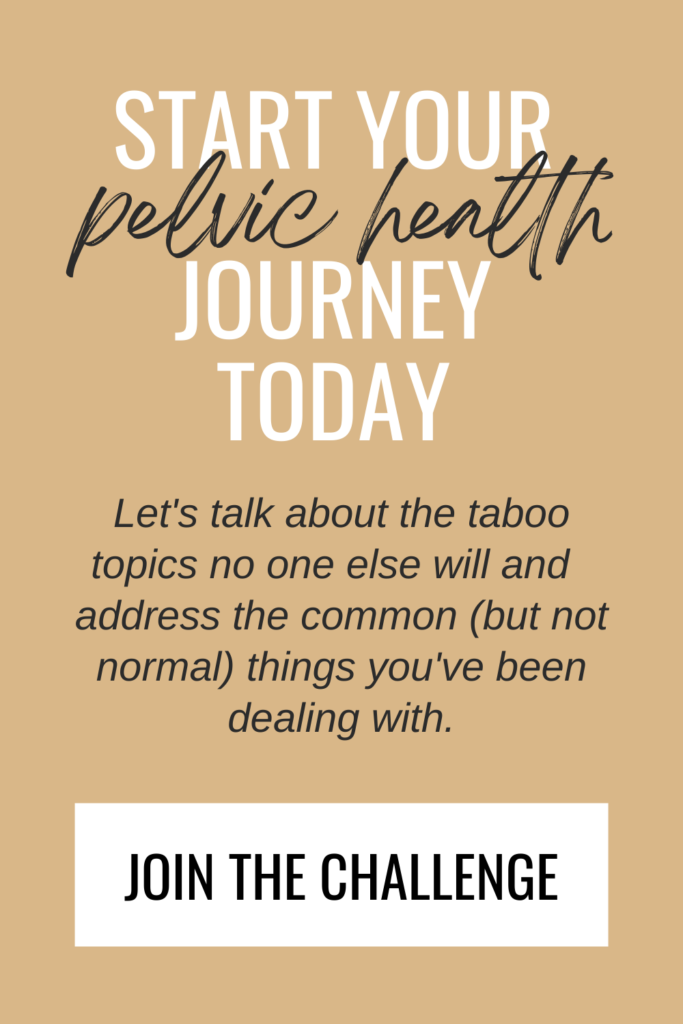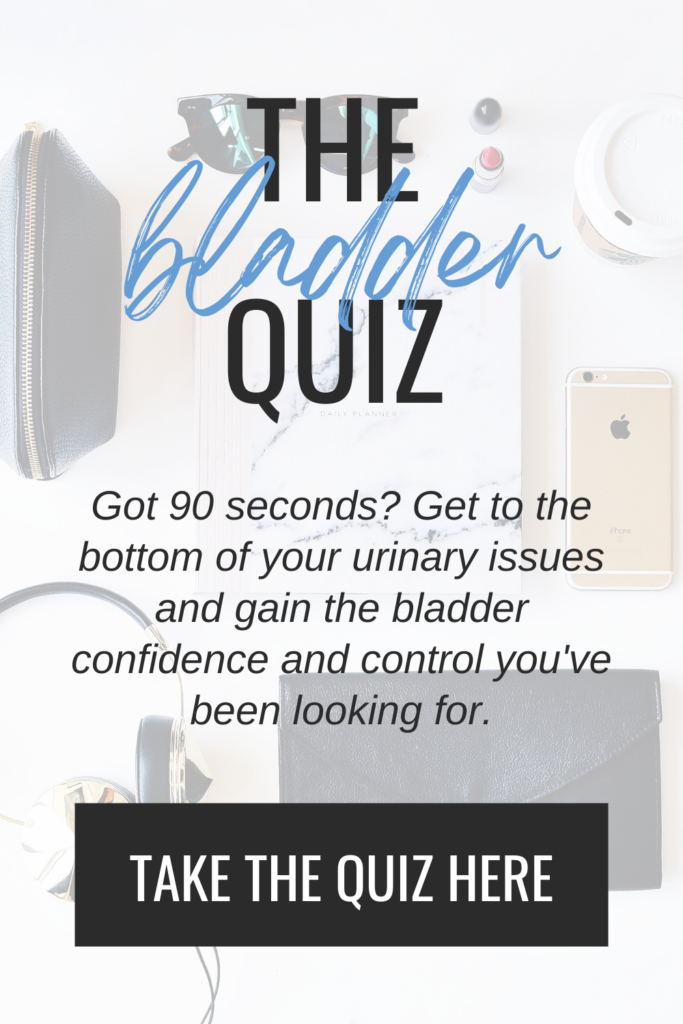If you have bladder issues like leakage, urgency, frequency, prolapse, or pain, then you’re struggling alongside 33% (plus) women in the world. So the company?…it’s pretty darn good, but the commonality??…noooooot so much. While bladder problems are deemed “normal” by society, especially in those of the female gender, older in age, or with a longer birth history, many women are rightfully wondering if they could/would/should be doing something about it.
As a pelvic rehab therapist, it’s my ~obvious~ opinion that you don’t have to live with bladder complaints, mainly because I see my patients resolving their once “impossible” issues on the daily. I also know the mental and emotional toll of living with bladder problems firsthand as I too am a postpartum mama who dealt with all of the above (you can read where my bladder healing journey started here), and those burdens are the last thing we need as the world-changing, wonder-women that we are.
The good news is, you’re never “too” anything to fix your bladder…too old, too young, too active, too sedentary, too far behind, too ahead of the game, too many births, too soon before babies, too busy, too broke, or too beyond help.
So now that your excuses have been eliminated— what are you doing? If you’re not proactively working to improve your bladder and pelvic floor health, you’re missing out on a life free of expensive pad-purchases, less than pleasant roadside restroom stops, avoiding the activities you once loved, and the multitude of negative feelings that come with them.
We all have a tipping point, that enough is enough line in the sand that forces us to finally take action. If you can check the boxes to one or more statements below, then you’ve reached your limit and I’m officially giving you permission and encouragement to commit your time, energy, and resources to your bladder troubles. It’s about to get real friend, but that’s the only way you’re gonna ~actually~ make a difference.
Your bladder’s controlling your life.
Ok, ok…maybe that’s a bit dramatic, but it can get to this point. If you always pee before you leave the house, only participate in certain workouts because of [that] movement, wear clothes that hide pads or camouflage leakage, refuse to travel places that don’t have a restroom, or limit the amount of fluid you drink, then I hate to break it to ya, but your bladder’s officially in charge.
These restrictions and stipulations on your day aren’t normal and just because you’ve been living with them for as long as you can remember doesn’t mean you should tolerate it for any longer. If you think about your bladder at all during the day (more than the normal “ok…I think I’ll use the restroom now” six to eight times in a 24-hour period) then it’s taken an unacceptable amount of control over your life, and there’s definitely room for improvement.
Your symptoms are getting worse.
Most bladder issues start out small with a little leakage when sneezing here, the extra bathroom run after a cup of coffee there (sound familiar???), but if left untreated, you may find the frequency and severity of your problems increase over time.
This is normal— this is your body telling you there’s a problem and beeeeeegging you to address it. Because pantilineres turn into diapers, pain with urination can become chronic bladder spasms, and leakage can lead to a pelvic organ prolapse— all things that are harder to fix as time goes on.
Think back one year…ten years (!!!), and compare where you bladder problems are [now] in contrast to when they first started. Symptoms tend to worsen slowly and sneakily, often without us even noticing, which is how it gets so bad and why we often let it go as long as we do. You can stop the progression, but you ~must~ acknowledge it first.
You spend more energy on being frustrated than fixing the issue.
Have you ever heard the saying that it takes more muscles to frown than to smile? My laugh lines might tell you otherwise, but it’s an overall known fact that simply addressing a problem is easier than living in that problem itself. Kiiiiiind of the same, but you get where I’m going with this.
The restroom stops, clothing changes, constant worry, avoidance and embarrassment… those are all taking more physical, mental, and emotional energy from you than you realize. Far more than the few minutes a day of thoughtful exercises required to resolve your bladder problems.
Not knowing where to start or past attempts followed by failures are often what stop people from taking action, but you can no longer use that excuse. I have the answers to your bladder issues…I know that for a fact. You just need to direct your energy in the right places, and proactive healing is where you’ll get the most bang for your buck.
What you’ll gain is greater than what you’ll lose.
Life hack alert— I ask myself this one whenever I have a big decision or daunting task in front of me. Will the cost of doing this [thing] be worth what I’ll gain at the end? S’good…right?? So let’s break it down…
The cost of addressing your bladder problems:
~ Time to learn and implement new strategies
~ Energy towards the mindfulness, awareness, and exercises required to see change in your bladder health
~ Money (depending on what route you choose) for appointments, courses, and guidance
~ Discomfort and vulnerability to admit the issue and step outside of your comfort zone to address it
The reward of addressing your bladder problems:
~ More time to do what you want (when and how you want to do it) without worrying about your bladder
~ More energy to dedicate to the things that light you up without your bladder getting in the way
~ More money to do the fun things rather than spending it on appointments, pads, and dry cleaning
~ Confidence, peace, and control over the same bladder that used to cause you nothing but frustration
This is an easy pro/con list IMO, but you’ll have to make your own if the above points don’t resonate with you. No matter how your list plays out, I can almost guarantee that the costs are temporary, benefits are forever, and I can’t encourage you enough to take the whole picture into account.
Ummmmmmm, gut check anyone? If any of these key signs hit ya where it hurts, then you’re without a doubt ready to take action. I believe in your ability to heal if you make your health a priority and truly let those statements above be your guiding “why” behind the commitment and energy it takes to see results. TBH— it really doesn’t take that much when you’re doing all the right things (keep reading for those), but it does require awareness, mindfulness, aaaaaand an exercise or two along the way.
>>> For my dip your toes in kinda gals, this two-minute bladder healing quiz is a great place to start. You answer questions to get to the bottom of your specific bladder problems, then I send the ~exact~ strategies you need to see success straight to your inbox. I mean…c’mon!
>>> If you want to do your own research and pick what works best for you from an expertly curated library of info, the bladder board on my Pinterest page is where you can find my top recommendations on the topic. Begin implementing whatever you feel speaks to your issues and keep following for further guidance.
>>> For those who don’t have time to waste and want to get right to the results, my 8-week online course, The Bladder Blueprint guides you through the same treatment strategies I use in my pelvic health clinic to see improvement in your bladder from the comfort of your couch. This is like having your own personal pelvic rehab therapist without the insurance confusion, provider wait list, crowded waiting rooms, or jamming appointments into a busy schedule.
All you have to do is say “yes” and click one of the above to get started. I know what it takes to heal your bladder, and I also know Y-O-U have what it takes to get there. If you haven’t figured it out already, I’m right here to help you in whatever way I can. You take that first step and I’ll be right there with ya.
– Amanda
Disclaimer: The content provided here does not constitute medical advice, nor is it a substitute for personalized healthcare. If you have concerns about a medical condition, diagnosis, or treatment, you should consult with a licensed healthcare professional.



















